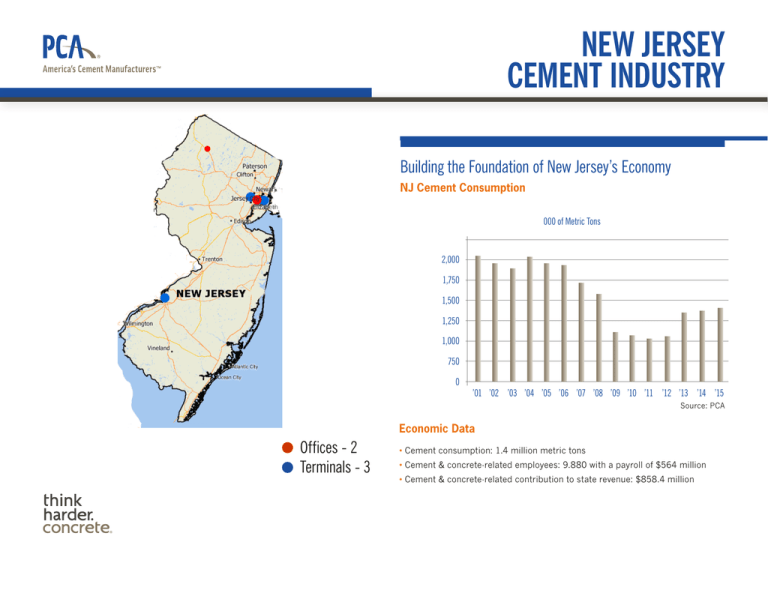
NEW JERSEY
CEMENT INDUSTRY
Building the Foundation of New Jersey’s Economy
NJ Cement Consumption
000 of Metric Tons
2,000
1,750
1,500
1,250
1,000
750
0
’01 ’02 ’03 ’04 ’05 ’06 ’07 ’08 ’09 ’10 ’11 ’12 ’13 ’14 ’15
Source: PCA
Economic Data
Offices - 2
Terminals - 3
• Cement consumption: 1.4 million metric tons
• Cement & concrete-related employees: 9.880 with a payroll of $564 million
• Cement & concrete-related contribution to state revenue: $858.4 million
NEW JERSEY CEMENT INDUSTRY
PORTLAND CEMENT MANUFACTURING AND USE
Portland Cement Association (PCA) represents 93% of US cement manufacturing
capacity with over 90 plants in 32 states and distribution facilities in every state
in the continental U.S.
Cement or concrete? Concrete is basically a mixture of aggregates and paste.
The aggregates are sand and gravel or crushed stone; the paste is water and
cement. Portland cement is not a brand name, but the generic term for the type
of cement used in virtually all concrete, just as stainless is a type of steel and
sterling a type of silver.
Cement is manufactured by heating lime, silica, alumina, iron, and other
materials at high temperature. The resulting substance is a marble-like ball
called clinker that is ground, mixed with limestone and gypsum, and used to
create concrete.
The U.S. cement industry has long been committed to minimizing emissions, waste, energy
consumption, and the use of virgin raw materials. For example, the cement industry began to
address climate change in the mid-1990s—one of the first industries to do so.
Portland cement is an essential construction material and is uniquely positioned for the
rebuilding of American infrastructure.
• U.S. cement companies have annual shipments valued at approximately
$9 billion.
• Cement manufacturers in the U.S. employ over 14,300 workers with an
annual payroll of nearly $1 billion. When including related industries such as
concrete, the number of employees grows to nearly 535,000 with a payroll of
approximately $25 billion.
© 2016 Portland Cement Association
All rights reserved
0022-12-200
Concrete is a responsible choice for sustainable, durable development. It offers an economic way to
build resilient communities and infrastructure.
• Building owners, builders, architects, and designers have come to recognize that
durable concrete public buildings, private homes, and businesses resist damage from
natural disasters and reduce the impact entire communities have on our planet.
• A National Institute of Building Sciences Multi-Hazard Mitigation Council study
reported that every dollar spent on reducing the potential impact of disasters
saves society an average of $4. With durable construction, the damage
from major storms can be less severe, reducing the amount of energy and
resources that the local community will have to spend on emergency response,
reconstruction, repair, and recovery.
• The heating, cooling, and general operations of buildings and homes in the United
States accounts for approximately 70 percent of national energy consumption
each year and more than 40 percent of CO2 emissions generated in the U.S.
• Studies by MIT have shown that homes with concrete walls can use 8 to 15
percent less energy than other homes.
• MIT research has also shown that pavements with greater stiffness produce a
better fuel economy for the vehicles that travel on them. To achieve optimal fuel
consumption figures, asphalt pavement would need to be about 60 percent thicker
than concrete pavement. Concrete pavements not only cost less to build, but would in
this case, use less virgin material



